|
1
|
International Diabetes Federation (IDF), .
IDF Diabetes Atlas. 7th. IDF; Brussels: 2015
|
|
2
|
Tabák AG, Herder C, Rathmann W, Brunner EJ
and Kivimäki M: Prediabetes: A high-risk state for diabetes
development. Lancet. 379:2279–2290. 2012. View Article : Google Scholar : PubMed/NCBI
|
|
3
|
Grundy SM: Pre-diabetes, metabolic
syndrome, and cardiovascular risk. J Am Coll Cardiol. 59:635–643.
2012. View Article : Google Scholar : PubMed/NCBI
|
|
4
|
Knowler WC, Fowler SE, Hamman RF,
Christophi CA, Hoffman HJ, Brenneman AT, Brown-Friday JO, Goldberg
R, Venditti E and Nathan DM: Diabetes Prevention Program Research
Group: 10-year follow-up of diabetes incidence and weight loss in
the Diabetes Prevention Program Outcomes Study. Lancet.
374:1677–1686. 2009. View Article : Google Scholar : PubMed/NCBI
|
|
5
|
Gerstein HC, Yusuf S, Bosch J, Pogue J,
Sheridan P, Dinccag N, Hanefeld M, Hoogwerf B, Laakso M, Mohan V,
et al: DREAM (Diabetes REduction Assessment with ramipril and
rosiglitazone Medication) Trial Investigators: Effect of
rosiglitazone on the frequency of diabetes in patients with
impaired glucose tolerance or impaired fasting glucose: A
randomised controlled trial. Lancet. 368:1096–1105. 2006.
View Article : Google Scholar : PubMed/NCBI
|
|
6
|
Knowler WC, Barrett-Connor E, Fowler SE,
Hamman RF, Lachin JM, Walker EA and Nathan DM: Diabetes Prevention
Program Research Group: Reduction in the incidence of type 2
diabetes with lifestyle intervention or metformin. N Engl J Med.
346:393–403. 2002. View Article : Google Scholar : PubMed/NCBI
|
|
7
|
Ramachandran A, Snehalatha C, Mary S,
Mukesh B, Bhaskar AD and Vijay V: Indian Diabetes Prevention
Programme (IDPP): The Indian Diabetes Prevention Programme shows
that lifestyle modification and metformin prevent type 2 diabetes
in Asian Indian subjects with impaired glucose tolerance (IDPP-1).
Diabetologia. 49:289–297. 2006. View Article : Google Scholar : PubMed/NCBI
|
|
8
|
Heianza Y, Hara S, Arase Y, Saito K,
Fujiwara K, Tsuji H, Kodama S, Hsieh SD, Mori Y, Shimano H, et al:
HbA1c 5·7-6·4% and impaired fasting plasma glucose for diagnosis of
prediabetes and risk of progression to diabetes in Japan (TOPICS
3): A longitudinal cohort study. Lancet. 378:147–155. 2011.
View Article : Google Scholar : PubMed/NCBI
|
|
9
|
Tabák AG, Jokela M, Akbaraly TN, Brunner
EJ, Kivimäki M and Witte DR: Trajectories of glycaemia, insulin
sensitivity, and insulin secretion before diagnosis of type 2
diabetes: An analysis from the Whitehall II study. Lancet.
373:2215–2221. 2009. View Article : Google Scholar : PubMed/NCBI
|
|
10
|
Node K and Inoue T: Postprandial
hyperglycemia as an etiological factor in vascular failure.
Cardiovasc Diabetol. 8:232009. View Article : Google Scholar : PubMed/NCBI
|
|
11
|
Trapp C and Levin S: Preparing to
prescribe plant-based diets for diabetes prevention and treatment.
Diabetes Spectrum. 25:38–44. 2012. View Article : Google Scholar
|
|
12
|
Orlich MJ and Fraser GE: Vegetarian diets
in the Adventist Health Study 2: A review of initial published
findings. Am J Clin Nutr. 100(Suppl 1): 353S–358S. 2014. View Article : Google Scholar : PubMed/NCBI
|
|
13
|
Yokoyama Y, Barnard ND, Levin SM and
Watanabe M: Vegetarian diets and glycemic control in diabetes: A
systematic review and meta-analysis. Cardiovasc Diagn Ther.
4:373–382. 2014.PubMed/NCBI
|
|
14
|
Hobden MR, Guérin-Deremaux L, Rowland I,
Gibson GR and Kennedy OB: Potential anti-obesogenic properties of
non-digestible carbohydrates: Specific focus on resistant dextrin.
Proc Nutr Soc. 74:258–267. 2015. View Article : Google Scholar : PubMed/NCBI
|
|
15
|
Murayama Y, Mochizuki K, Shimada M,
Fujimoto S, Nukui K, Shibata K and Goda T: Dietary supplementation
with alpha-amylase inhibitor wheat albumin to high-fat diet-induced
insulin-resistant rats is associated with increased expression of
genes related to fatty acid synthesis in adipose tissue. J Agric
Food Chem. 57:9332–9338. 2009. View Article : Google Scholar : PubMed/NCBI
|
|
16
|
Korenori Y, Suzuki A, Kurokawa M and Saito
J: Beneficial effects of dietary intake of food containing kale
(Brassica oleracea var. acephala) on postprandial blood glucose in
humans. A randomized, placebo-controlled, double-blind, crossover
study. Jpn Pharmacol Ther. 43:1157–1163. 2015.
|
|
17
|
Kim SY: Comparison of nutritional
compositions and antioxidant activities of building blocks in
shinseoncho and kale green vegetable juices. Prev Nutr Food Sci.
17:269–273. 2012. View Article : Google Scholar : PubMed/NCBI
|
|
18
|
Sikora E and Bodziarczyk I: Composition
and antioxidant activity of kale (Brassica oleracea L. var.
acephala) raw and cooked. Acta Sci Pol Technol Aliment. 11:239–248.
2012.PubMed/NCBI
|
|
19
|
Ismail A, Marjan ZM and Foong CW: Total
antioxidant activity and phenolic content in selected vegetables.
Food Chem. 87:581–586. 2004. View Article : Google Scholar
|
|
20
|
Migliozzi M, Thavarajah D, Thavarajah P
and Smith P: Lentil and kale: Complementary nutrient-rich whole
food sources to combat micronutrient and calorie malnutrition.
Nutrients. 7:9285–9298. 2015. View Article : Google Scholar : PubMed/NCBI
|
|
21
|
Lattimer JM and Haub MD: Effects of
dietary fiber and its components on metabolic health. Nutrients.
2:1266–1289. 2010. View Article : Google Scholar : PubMed/NCBI
|
|
22
|
Lightowler HJ and Henry CJ: Glycemic
response of mashed potato containing high-viscocity
hydroxypropylmethylcellulose. Nutr Res. 29:551–557. 2009.
View Article : Google Scholar : PubMed/NCBI
|
|
23
|
Maki KC, Davidson MH, Witchger MS, Dicklin
MR and Subbaiah PV: Effects of high-fiber oat and wheat cereals on
postprandial glucose and lipid responses in healthy men. Int J
Vitam Nutr Res. 77:347–356. 2007. View Article : Google Scholar : PubMed/NCBI
|
|
24
|
American Diabetes Association: 5, .
Glycemic Targets. Diabetes Care. 39(Suppl 1): S39–S46.
2016.PubMed/NCBI
|

















